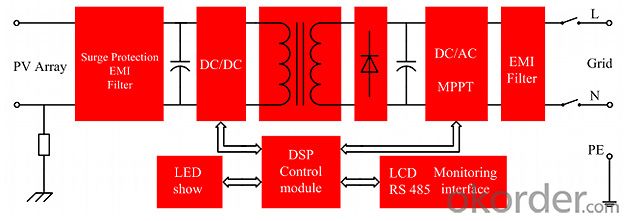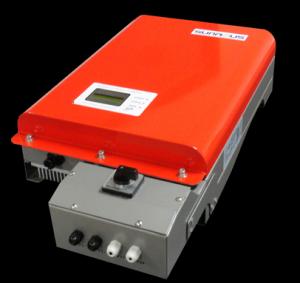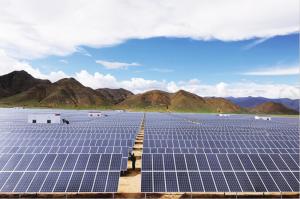High Frequency Transformer Isolation PV Grid-Tied Inverter
- Loading Port:
- Shanghai
- Payment Terms:
- TT or LC
- Min Order Qty:
- 20 pc
- Supply Capability:
- 1000 pc/month
OKorder Service Pledge
OKorder Financial Service
You Might Also Like
High Frequency Transformer Isolation PV Grid-Tied Inverter
LF series 0.6kw — 1.5kw
Features: Single stage inverter is the main characteristic of this product , in which power grade period compared with other topological structure has higher conversion effciency and reliability
characteristics:
5 years warranty
· Sealing stainless steel shell, suitable for indoor or outdoor installation
· High frequency transformer isolation
· The highest effciency achieves 98%
· Wide input Voltage range
· Adopt connectors type cable connection, Easy operation and installation
· Best tracking effciency with OptiTrac MPP control
· operating temperature range -25 ℃ to + 55℃
· High reliability due to complete protection function
· Anti-theft protection
· Plug-in grounding
HF series 1.5kw — 5.0kw

High frequency transformer isolation is the main feature of our production, which make Installation easier due to the reduced weight and higher conversion effciency because of omitting Low frequency transformer. The wide input voltage range from 180 to 600volt gives you extraordinary fexibility for you system design. Not need to set graphic display and RS485 communication system make the devices highly user-friendly.
This product can by multi-level parallel combination for 6kw to 20kw needed any power grade HF series technical parameter.
parameters:
GT1.5-ZX-01/HF | GT2.0-ZX-01/HF | GT2.5-ZX-01/HF | GT3.0-ZX-01/HF | GT4.0-ZX-01/HF | GT5.0-ZX-01/HF | |
Input(DC) | ||||||
Max.DC Power | 1600W | 2100W | 2650W | 3150W | 4200W | 5200W |
Max.DC Voltage | 600V | |||||
PV Voltage range, MPPT | 150V ~ 550V | 150V ~ 550V | ||||
Max.input current | 10.0A | 14.0A | 16.0A | 20.0A | 25.0A | 30.0A |
Number of MPP trackers | 1 | |||||
Max.number of strings (parallel) | 1 | 1 | 2 | 2 | 3 | 3 |
Output(AC) | ||||||
Nominal AC power / | 1500W | 2000W | 2500W | 3000W | 4000W | 5000W |
Max.output current | 13.0A/7.0A | 17.0A/9.0A | 21.0A/12.0A | 25.0A/14.0A | 21.0A | 30.0A |
Nominal AC Voltage / range | 102-138Vac/180-264Vac | 180-270Vac | ||||
AC grid frequency / range | 47.5-51.5Hz / 59.3-60.5Hz | |||||
Power factor at rated power | 1 | |||||
THD | < 3% | |||||
AC connection | Single-phase | |||||
Efficiency | ||||||
Max. efficiency/Californian efficiency | > 98.0% / > 97.0% | |||||
MPP adaptation efficiency | > 99.0% | |||||
Protection devices | ||||||
DC reverse polarity protection | √ | |||||
AC short-circuit protection | √ | |||||
Ground fault monitoring | √ | |||||
Grid monitoring | √ | |||||
Output Transient Voltage Suppression | √ | |||||
Over load | √ | |||||
Anti-islanding | √ | |||||
General data | ||||||
Dimensions (W/ H / D) in mm | 350 / 560 / 160 | 370 / 540 / 185 | ||||
Weight(Kg) | 16 | 19 | 23 | |||
Operating temperature range | -25 ~ +60℃ | |||||
Storage temperature range | -40 ~ +70℃ | |||||
Ambient humidity | 0 ~ 100% | |||||
Consumption (night) | < 0.5W | |||||
Topology | HF-transformer galvanic isolation | |||||
Cooling concept | Convection | |||||
Enclosure type | IP65 / NEMA 3R | |||||
Features | ||||||
DC connection: PV special connector | √ | |||||
AC connection: connector | √ | |||||
LCD display & Backlit | √ | |||||
LED display | √ | |||||
Interfaces: RS485 | √ | |||||
Warranty: 10 years | √ | |||||
Certificates & approvals | G83 / G59 / TUV / SAA / ETL / JET/ CE | |||||

- Q:Can a solar inverter be used with a solar-powered EV charging network?
- Yes, a solar inverter can be used with a solar-powered EV charging network. A solar inverter converts the direct current (DC) generated by solar panels into alternating current (AC) that can be used to power electric vehicles (EVs). By integrating a solar inverter into a solar-powered EV charging network, the excess solar energy can be efficiently utilized to charge EVs, reducing dependence on the grid and promoting sustainable transportation.
- Q:How does a solar inverter impact the payback period of a solar system?
- A solar inverter plays a crucial role in the payback period of a solar system. It converts the direct current (DC) electricity generated by solar panels into alternating current (AC) electricity that is usable for homes or businesses. A high-quality solar inverter ensures maximum energy efficiency, allowing the solar system to generate and utilize more electricity effectively. By optimizing energy production, a solar inverter can significantly reduce the payback period of a solar system, allowing users to recoup their initial investment and start saving on electricity bills more quickly.
- Q:Can a solar inverter be installed indoors or outdoors?
- A solar inverter can be installed both indoors and outdoors, depending on the specific requirements and preferences of the installation. However, it is essential to consider factors such as available space, ventilation, temperature regulation, and protection from environmental elements when deciding on the installation location.
- Q:What is the maximum number of solar panels that a solar inverter can support?
- The maximum number of solar panels that a solar inverter can support depends on the specific model and capacity of the inverter. Different inverters have different power ratings and input capacities, which determine the number of solar panels they can handle. It is important to consult the manufacturer's specifications or consult with a professional to determine the appropriate number of panels that can be supported by a particular solar inverter.
- Q:Can a solar inverter be used in a mobile or RV application?
- Yes, a solar inverter can be used in a mobile or RV application. It allows the conversion of direct current (DC) from solar panels into alternating current (AC) that can be used to power appliances, devices, and other electrical equipment inside the mobile or RV. This enables the vehicle to utilize solar energy for various power needs while on the move.
- Q:What is the role of a DC-DC converter in a solar inverter?
- The role of a DC-DC converter in a solar inverter is to convert the direct current (DC) generated by the solar panels into the appropriate voltage level required for the inverter to convert it into alternating current (AC) electricity. This conversion ensures efficient power transfer from the solar panels to the grid or for use in residential or commercial applications.
- Q:Can a solar inverter be used with different types of grounding configurations?
- Yes, a solar inverter can be used with different types of grounding configurations. However, it is important to ensure that the inverter is compatible with the specific grounding configuration being used in order to maintain safety and performance.
- Q:Can a solar inverter be used with energy storage systems?
- Yes, a solar inverter can be used with energy storage systems. In fact, it is a crucial component in connecting solar panels with energy storage batteries. The solar inverter converts the direct current (DC) electricity generated by the solar panels into alternating current (AC) electricity, which can be used to power appliances and charge the energy storage system. Additionally, the inverter also manages the flow of electricity between the solar panels, energy storage system, and the grid, ensuring efficient and reliable power supply.
- Q:How does a solar inverter handle variations in solar irradiation?
- A solar inverter handles variations in solar irradiation by continuously monitoring the incoming solar energy and adjusting its output accordingly. It uses maximum power point tracking (MPPT) technology to ensure that it extracts the maximum power available from the solar panels under different irradiation levels. This allows the inverter to regulate the voltage and current output to match the varying solar conditions, ensuring optimal efficiency and power conversion.
- Q:How do you calculate the power loss in a solar inverter?
- To calculate the power loss in a solar inverter, you would subtract the output power of the inverter from its input power. The input power can be determined by measuring the DC current and voltage at the input, while the output power can be determined by measuring the AC current and voltage at the output. The difference between the input and output power represents the power loss in the solar inverter.
1. Manufacturer Overview |
|
|---|---|
| Location | |
| Year Established | |
| Annual Output Value | |
| Main Markets | |
| Company Certifications | |
2. Manufacturer Certificates |
|
|---|---|
| a) Certification Name | |
| Range | |
| Reference | |
| Validity Period | |
3. Manufacturer Capability |
|
|---|---|
| a)Trade Capacity | |
| Nearest Port | |
| Export Percentage | |
| No.of Employees in Trade Department | |
| Language Spoken: | |
| b)Factory Information | |
| Factory Size: | |
| No. of Production Lines | |
| Contract Manufacturing | |
| Product Price Range | |
Send your message to us
High Frequency Transformer Isolation PV Grid-Tied Inverter
- Loading Port:
- Shanghai
- Payment Terms:
- TT or LC
- Min Order Qty:
- 20 pc
- Supply Capability:
- 1000 pc/month
OKorder Service Pledge
OKorder Financial Service
Similar products
New products
Hot products
Hot Searches
Related keywords































